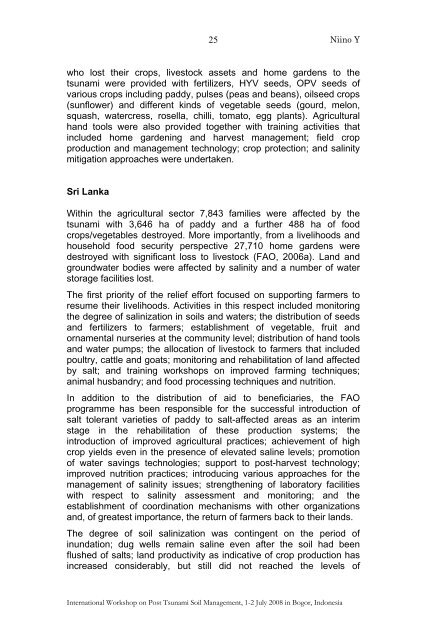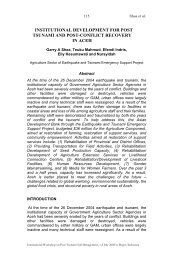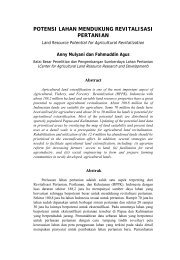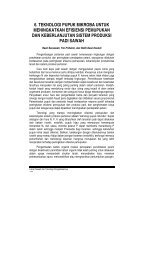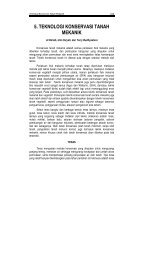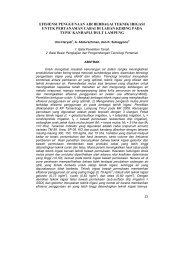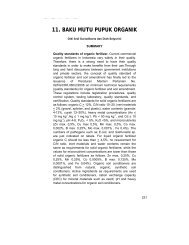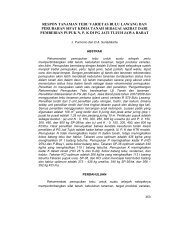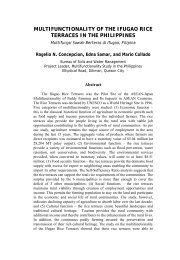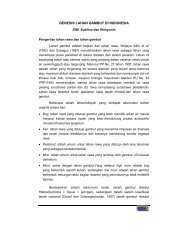Proceedings - Balai Penelitian Tanah
Proceedings - Balai Penelitian Tanah
Proceedings - Balai Penelitian Tanah
You also want an ePaper? Increase the reach of your titles
YUMPU automatically turns print PDFs into web optimized ePapers that Google loves.
25<br />
Niino Y<br />
who lost their crops, livestock assets and home gardens to the<br />
tsunami were provided with fertilizers, HYV seeds, OPV seeds of<br />
various crops including paddy, pulses (peas and beans), oilseed crops<br />
(sunflower) and different kinds of vegetable seeds (gourd, melon,<br />
squash, watercress, rosella, chilli, tomato, egg plants). Agricultural<br />
hand tools were also provided together with training activities that<br />
included home gardening and harvest management; field crop<br />
production and management technology; crop protection; and salinity<br />
mitigation approaches were undertaken.<br />
Sri Lanka<br />
Within the agricultural sector 7,843 families were affected by the<br />
tsunami with 3,646 ha of paddy and a further 488 ha of food<br />
crops/vegetables destroyed. More importantly, from a livelihoods and<br />
household food security perspective 27,710 home gardens were<br />
destroyed with significant loss to livestock (FAO, 2006a). Land and<br />
groundwater bodies were affected by salinity and a number of water<br />
storage facilities lost.<br />
The first priority of the relief effort focused on supporting farmers to<br />
resume their livelihoods. Activities in this respect included monitoring<br />
the degree of salinization in soils and waters; the distribution of seeds<br />
and fertilizers to farmers; establishment of vegetable, fruit and<br />
ornamental nurseries at the community level; distribution of hand tools<br />
and water pumps; the allocation of livestock to farmers that included<br />
poultry, cattle and goats; monitoring and rehabilitation of land affected<br />
by salt; and training workshops on improved farming techniques;<br />
animal husbandry; and food processing techniques and nutrition.<br />
In addition to the distribution of aid to beneficiaries, the FAO<br />
programme has been responsible for the successful introduction of<br />
salt tolerant varieties of paddy to salt-affected areas as an interim<br />
stage in the rehabilitation of these production systems; the<br />
introduction of improved agricultural practices; achievement of high<br />
crop yields even in the presence of elevated saline levels; promotion<br />
of water savings technologies; support to post-harvest technology;<br />
improved nutrition practices; introducing various approaches for the<br />
management of salinity issues; strengthening of laboratory facilities<br />
with respect to salinity assessment and monitoring; and the<br />
establishment of coordination mechanisms with other organizations<br />
and, of greatest importance, the return of farmers back to their lands.<br />
The degree of soil salinization was contingent on the period of<br />
inundation; dug wells remain saline even after the soil had been<br />
flushed of salts; land productivity as indicative of crop production has<br />
increased considerably, but still did not reached the levels of<br />
International Workshop on Post Tsunami Soil Management, 1-2 July 2008 in Bogor, Indonesia


